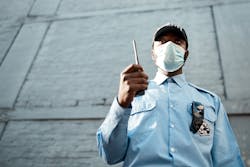Critical Infrastructure Protection With the Human Touch
Feet on the ground or security technologies? The benefits of having feet on the ground (security officers) versus security technologies to mitigate facility risk continues to be a debatable topic. Some security professionals argue the benefits of having feet on the ground, while others will argue the benefits of embracing technologies. Professionally, I fall in the middle.
However, the question of feet versus technology takes on a whole new point of view during a pandemic, especially if you don't have the feet to put on the ground. Sure, you can reduce staffing levels, but what happens when you don't have the staff to reduce. You can't simply lock the doors of a critical infrastructure facility and send everyone home.
You may use access control, video surveillance and intrusion technologies to protect property assets, but are they disparate systems that don't talk to each other, are they integrated, or better yet unified? Are you and your service provider on the same page when it comes to communicating plans? How do you keep the systems up and running if your service provider cannot work during a crisis?Just because you may have a plan doesn't mean everyone else has a plan. During the pandemic, many of my physical security consulting projects were placed on hold. It wasn't the best situation to be in, but it allowed my team to help our clients develop COVID protocols to help keep them operational and providing services while on a client's site. It wasn't about keeping their operations up and running as much as it was about keeping their employees working on a client's site.
Regardless Of Company Size, You Need A Plan
I was lucky; LARGO Consulting Services had a plan and could pivot to providing remote services to our clients. What we discovered was that not everyone has a plan or updates it regularly if they do have one. The most alarming discovery was that no one understood the importance of aligning their emergency response plans, electronic security systems with their feet on the ground.
Sometimes it is best just to do the math. While reviewing a client's active shooter plan, I realized that the numbers didn't add up; the plan called for more security officers being assigned responsibilities than are assigned to the facility. Since they couldn't hire any additional feet, we designed a technology solution to automatically lockdown the doors and used video surveillance and analytics to monitor areas of the facility actively. Best of all, the system will pay for itself over three years since we could reduce the number of feet on the ground.
Today's electronic security systems are smart, but that intelligence sometimes is not employed because no one asked the right questions. As an end-user, one of my biggest frustrations was the lack of communication from my security integrator regarding new technologies, so I became an educated consumer. I learned as much as possible about my security systems and would consistently push my technology partners to provide the latest technologies to secure our most valued assets.
I realized early that feet and technology can work hand in hand to optimize your security resources, and one won't necessarily replace the other. Combined feet and technology provide the best solution.
Pandemic Lessons Learned
The COVID-19 pandemic has been an eye-opener for everyone responsible for providing security services, raising the question, "how do we provide facility protection while continuing to mitigate risk during a pandemic?" The answer is relatively simple -- we adjust to the situation presented.
For years security professionals have been told how important it is to develop emergency response plans to cover everything from an active shooter incident to a tsunami. During my tenure as the Associate Vice President of Public Safety at Drexel University, I had the opportunity to work with the City of Philadelphia Health Officials on developing a pandemic response plan and point of a distribution plan for college campuses.
The plan took months to develop, but we never realized how the project would play out until we did a live situational exercise. Within a few minutes of the exercise, we knew what parts of the plan would or wouldn't work and adjusted accordingly. Little did we know at the time that the response plan and distribution plan would have to be activated during the 2009 H1N1 pandemic.
Fast forward to 2020, and once again, a pandemic would test security professionals’ ability to provide a high level of security while ensuring our security teams' health and safety. Security professionals had to be creative in finding ways to social distance, operate while wearing a mask and having a reduced work staff due to illness or downsizing.
Additionally, there was a need to remotely manage and monitor security systems without jeopardizing IP protocols when allowing remote access to secure networks. Facilities that have a dedicated Security Operation Center may be able to control security systems across their enterprise, however, smaller facilities may not have the necessary resources and scrambled to find a solution.
We would also learn that essential workers include more than emergency responders, healthcare providers, law enforcement, facilities personnel and security officers. It takes many people to keep a facility up and running even when employees can work remotely. Usually, an emergency will last a few hours, maybe a couple of days, but we are currently at 18 months and counting. Even as I am writing, the Center for Disease Control and Prevention is implementing new guidelines due to COVID-19 variants causing infection rates to increase.
Technology To The Rescue
During the pandemic, we saw the introduction of various security-related technologies related to mitigating the risk associated with COVID-19 that simplified a security team's ability to manage facility access. Some solutions were over-promised and under-delivered, while others will become a permanent addition to a facility's security and safety plans.
Touchless and frictionless access control devices will become mainstream for hardening facility access while also mitigating the spread of bacteria, germs and viruses. Touchless biometric technologies such as iris scanning, and facial recognition have proven effective and are publicly acceptable solutions. We have become so accustomed to using biometrics to unlock our phones that it's becoming an expected convenience.
Biometrics may be able to confirm a person's identity, but what about mobile credentialing? The biggest drawback to mobile credentialing has been the lack of a virtual credential or ID Card. That has changed. I had the opportunity to discuss the drawbacks of mobile credentialing recently at the ISC West event, specifically the lack of a virtual credential or ID Card. I was happy to see that the providers I spoke to now provide a virtual ID Card.
For mobile credentialing to be an effective access solution, manufacturers must understand the importance of providing a virtual ID Card that individuals can display upon request. If not, security professionals will not accept or support the use of mobile credentialing, no matter how convenient.
Using video surveillance to monitor a person's temperature provided various degrees of success, and the technology should get better over time. Combining video surveillance analytics to count people and provide facial recognition with access control technologies and automated report generation offers valuable information for contact tracing and managing social distancing crowd limits.
Mobile technologies can provide the ability for workers to remotely report health checks, promote social distancing, and provide real-time information related to possible exposure to a health risk.
Many of the technologies that came to market during the pandemic were designed to minimize the use of feet to do mundane tasks and deescalate potentially volatile interactions when individuals failed to comply with policies and procedures.
Letting Technologies Do The Grunt Work
Artificial Intelligence, analytics, video surveillance, radar detection, robotics and drone technologies continue to develop and provide solutions to do the grunt work we once had to rely on security officers to accomplish. FYI, as a security officer, I hated doing the grunt work.
Today we can rely on technology to do mundane tasks that once had to be done by security officers, allowing security professionals to do more with less while improving situational awareness, communication and incident response by combing feet and technology.
System Integration and Automated Triggers
Optimizing your facilities' security resources starts by selecting the technologies that will meet your security and safety objective today and well into the future. To make that happen you will want a unified, integrated, or hybrid solution to avoid managing disparate security systems.
- A unified solution built on the same platform and utilizing the same database can be beneficial since the software and devices work together seamlessly. A potential problem is that the whole may not be as good as the parts.
- An integrated solution allows for a lot of flexibility. It can tie your disparate systems together, but it can also be expensive and a headache to maintain depending on the systems and the magnitude of the integration. Integrated solutions can provide a robust solution, but buyers beware not all integration paths are easy. Past lessons learned have proven that seeing is believing.
- Hybrid solutions can offer the best of a unified and integrated security solution since technology partners have already vetted the technology to ensure it works as designed with the security platform of choice.
Once you have completed your homework and vetted your technology partners, it's time to get your feet and technology to work together. I recommend developing a list of triggers that provide actionable data that "if A happens, I want B to happen." For example, if someone breaches the facility's fence line, the alarm triggers the access control system to lock down the facility and sends a notification to the response team. The response team using GPS-enabled communication devices is tracked in real-time as they respond to the incident while also tracking any information shared during the response.
The actionable data pulled from the security systems, and connected devices should automatically trigger a response, dispatching personnel to the incident and notifying key stakeholders of the situation, optimizing available security resources. Additionally, the systems should log every action taken to make it easy to develop incident reports and after-action reports.
Protecting Your Investment
After installing, programming, and training personnel, don't forget to protect your investment. You must establish a preventive maintenance program, protect your system network and monitor all your devices. There is no excuse for not knowing that your network is under a cyberattack, a camera has stopped recording or a security device is offline.
You can manage all your devices, network security, firmware updates and system updates using a device diagnostic monitoring platform that provides network protection monitors security devices, system health and protects your data. Don't rely on your IT department to manage and monitor security devices. They have enough to do keeping the facilities network secure.
Now that you have the perfect security system aligned with your security personnel resources and emergency response plans, you should be ready to withstand any emergency that comes your way. You see, feet and technology do provide the perfect security solution during a crisis.
Bernard’s extensive career in public safety and security includes a breadth of roles that gives him a rare 360-degree perspective. The LARGO team specializes in physical security assessments and solutions, emergency preparedness, and crisis management, communication plans, training and project management. Get in touch with Bernard at [email protected]
About the Author

Bernard D. Gollotti, CPP
Founder of LARGO Consulting Services, LLC.
Bernard D. Gollotti, CPP, is the Founder/Owner & Principal Security Consultant of LARGO Consulting Services, LLC. Bernard works with companies, organizations, and educational institutions to find best-fit security solutions, engage people through social media, and develop new business strategies.
Bernard’s extensive career in public safety and security includes a breadth of roles that gives him a rare 360-degree perspective. He is a self-motivated professional who worked his way up the industry, starting as a security officer and quickly rising through the ranks to hold senior and executive positions. Under his leadership, the LARGO team specializes in physical security assessments and solutions, emergency preparedness, and crisis management, communication plans, training and project management. Get in touch with Bernard at [email protected]


